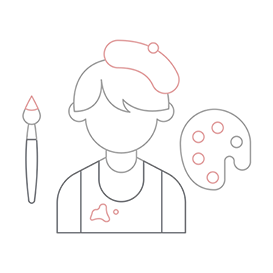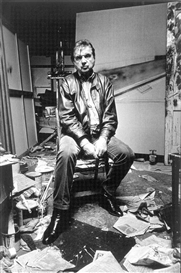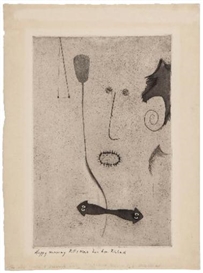Revealing Conversations Between 10 Post-War Painters
How does a painting come to fruition? Is it possible to reflect the artistic process in the finished product? This painterly process is examined in a remarkable show now open at London’s Haunch of Venison, illustrating how the artistic relationships between 10 post-war painters translated onto canvas.
���ϲ�����
Jan 25, 2012


3 works by very different yet equally influential post-war painters (Clockwise from left): "Pope I -Study of Pope Innocent X by Valasquez," 1951 by Francis Bacon (Aberdeen Art Gallery & Museums Collections; (c) The Estate of Francis Bacon); "Man in a Museum (Or You're In The Wrong Movie)" 1962 by David Hockney (British Council Collection; (c) David Hockney); "Primrose Hill, Winter Sunshine," 1962-64 by Frank Auerbach (Private Collection; (c) Frank Auerbach. Photo: Peter Mallet)
How does a painting come to fruition? Is it possible to reflect the artistic process in the finished product? Artist Francis Bacon attempted to resolve this issue in his work, inciting an artistic dialogue amongst his contemporaries. In an age dominated by abstract art, a group of British post-war artists resurrected figurative painting, collectively producing a vast and varied oeuvre that forever changed the face of modern art. This painterly process is examined in a remarkable show now open at London’s Haunch of Venison, illustrating how these hugely influential artists were connected, and how their artistic relationship translated onto their work.
Through February 18, The Mystery of Appearance explores the “conversations” amongst ten post-war modern painters: Michael Andrews, Frank Auerbach, Francis Bacon, Patrick Caulfield, William Coldstream, Lucian Freud, Richard Hamilton, David Hockney, Leon Kossoff and Euan Uglow. Featuring over 40 large and small scale
The show is curated by Catherine Lampert, with assistance from Tom Hunt, curator of the gallery’s London branch. In a recent interview with ���ϲ�����, Hunt discussed how these post-war painters influenced each other, revealing the mystery of the creative process.
���ϲ�����: What inspired the idea for the show? What’s the significance of the title?
Tom Hunt: There was a feeling that a group of post-war British artists were under-appreciated and to some extent misunderstood. The names of Bacon, Freud and Hockney are familiar, but Michael Andrews, Patrick Caulfield, William Coldstream, Leon Kossoff, Euan Uglow, even Frank Auerbach and Richard Hamilton, remain relatively unknown outside Britain. We wanted to change this by showing how central they are to any discussion of painting in the 20th century, and to highlight the diverse ways each artist ‘arrived’ at their respective pictures. (Above: "Mother and Child," by Richard Hamilton, 1984-85. Private Collection (c) The Estate of Richard Hamilton)
The title comes from a comment Bacon made to describe both the difficulty and the magic of making a painting come to life. He said, “To me, the mystery of painting today is how can appearance be made. I know it can be illustrated, I know it can be photographed. But how can this thing be made so that you catch the mystery of appearance within the mystery of the making?” The paintings here are not easily come by, they didn’t miraculously turn up on the canvas, but there is no formula for their emergence either. Through a process of observing a subject, thinking about it, returning to it and ultimately trusting your instincts and applying your hand to the canvas to translate it into paint, two-dimensional surfaces cohere into something worth looking at, something that tells the truth - however partial - about life.
MA: How/Why were these particular artists selected?
TH: The ten artists were chosen for their quality and their close personal relationships. The non-museum context allowed us to put together an exhibition that largely eschews chronology in favour of striking visual and emotional comparisons, hopefully creating what feels like a fluid and non-didactic experience.

Two of Hunt's favorite pieces in the show are these paintings by Michael Andrews: 'The Lord Mayor's Reception in Norwich Castle Keep, On the Eve of the Installation of the First Chancelor of the University of East Anglia,' and 'The Thames at Low Tide', because, as the curator says, "they show the same painter in completely different lights." Hunt's other favorites include the Auerbach 'Reclining Figure' "for its intimacy and clarity," and Hockney's 'The Room Tarzana' "...for its panache."
MA: Are there any common themes or subject matter specific to this group of artists?
TH: Drawing and painting from living motifs was key for most of these painters, but the influence of photography, philosophy and masterpieces from their own art historical traditions also factor in. Within the exhibition we see how Bacon responds to Velazquez, Uglow to Poussin, Kossoff to Rembrandt. They were inveterate art consumers and had strong opinions, from an aesthetic and philosophical point of view, about the direction contemporary art should take, most of them eager to move firmly away from the abstraction dominant in America at the time.
MA: Can you talk about some of the personal relationships between the artists? How did they influence each other’s work?

MA: What effect have their works had on younger generations of artists, and modern painting in general?
TH: These artists have had an incalculable effect [on the genre], partly through showing that painting can still be about looking at a subject and painting what you perceive, and through their introduction of abstract elements within ostensibly realist paintings.
The Mystery of Appearance: Conversations Between Ten British Post-War Painters is now showcased at London’s Haunch of Venison, until February 18th, 2012.
Who’s your favorite post-war painter? Do you think Bacon captured the "mystery of appearance"? Share your thoughts on the subject.

"Willesden Junction, Summer No. 1," 1966 by Leon Kossoff (Private Collection; (c) Leon Kossoff)
��
Written by ���ϲ����� Writer L. Meir














